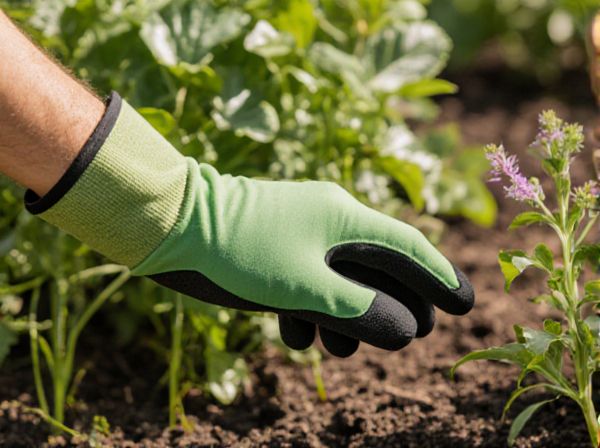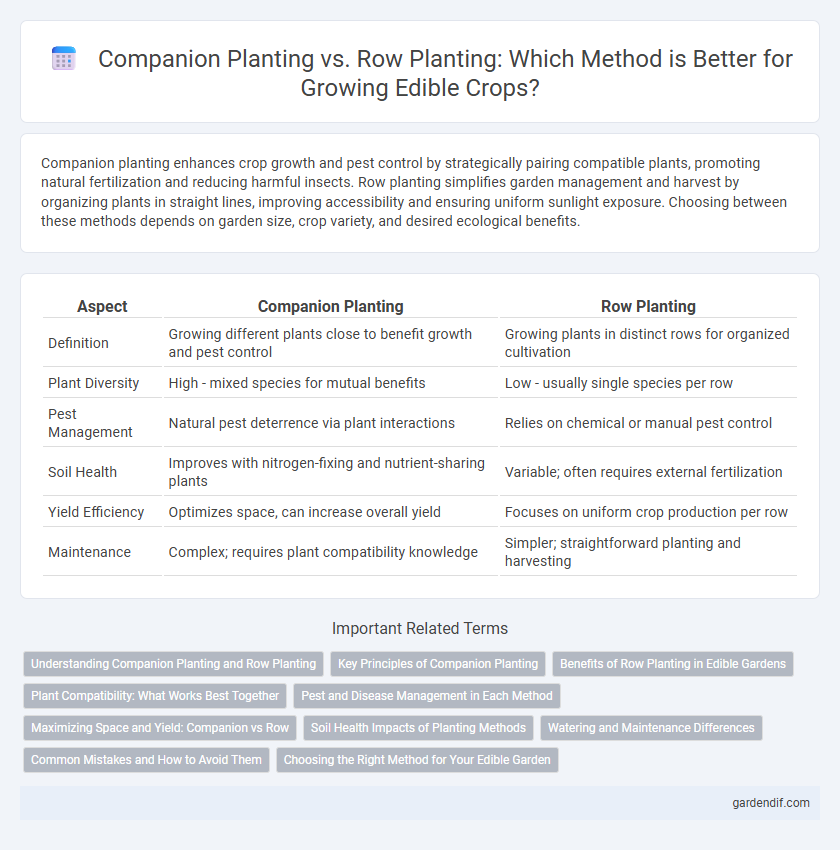
Companion Planting vs Row Planting Illustration
Companion planting enhances crop growth and pest control by strategically pairing compatible plants, promoting natural fertilization and reducing harmful insects. Row planting simplifies garden management and harvest by organizing plants in straight lines, improving accessibility and ensuring uniform sunlight exposure. Choosing between these methods depends on garden size, crop variety, and desired ecological benefits.
Table of Comparison
| Aspect | Companion Planting | Row Planting |
|---|---|---|
| Definition | Growing different plants close to benefit growth and pest control | Growing plants in distinct rows for organized cultivation |
| Plant Diversity | High - mixed species for mutual benefits | Low - usually single species per row |
| Pest Management | Natural pest deterrence via plant interactions | Relies on chemical or manual pest control |
| Soil Health | Improves with nitrogen-fixing and nutrient-sharing plants | Variable; often requires external fertilization |
| Yield Efficiency | Optimizes space, can increase overall yield | Focuses on uniform crop production per row |
| Maintenance | Complex; requires plant compatibility knowledge | Simpler; straightforward planting and harvesting |
Understanding Companion Planting and Row Planting
Companion planting enhances crop growth by strategically pairing plants like tomatoes and basil to improve nutrient uptake, pest control, and yield, while row planting organizes crops in linear sequences for efficient space use and mechanized maintenance. This method leverages natural plant relationships to boost ecosystem resilience and biodiversity, contrasting with row planting's emphasis on standardized spacing and simplicity. Understanding these techniques helps optimize garden productivity and sustainability by aligning planting strategies with crop requirements and environmental conditions.
Key Principles of Companion Planting
Companion planting involves strategically growing different plant species together to enhance growth, improve pest control, and increase crop yield through natural synergy. Key principles include selecting compatible plants that support each other's nutrient needs, pest resistance, and growth habits, such as planting nitrogen-fixing legumes alongside nitrogen-demanding vegetables. This method encourages biodiversity, optimizes space, and reduces the reliance on chemical fertilizers and pesticides, promoting sustainable and productive gardening.
Benefits of Row Planting in Edible Gardens
Row planting in edible gardens offers enhanced airflow and sunlight exposure, reducing the risk of fungal diseases and promoting healthier plant growth. This method facilitates efficient irrigation and easier access for maintenance, harvesting, and pest control. Consistent spacing in row planting supports optimal root development and maximizes crop yield per square foot.
Plant Compatibility: What Works Best Together
Companion planting enhances plant compatibility by strategically pairing species that support each other's growth, such as basil with tomatoes or marigolds with beans, enhancing pest control and nutrient uptake. Row planting tends to isolate crops, which may limit beneficial interactions but simplifies management and spacing. Selecting compatible plants in companion planting optimizes garden health and yields by leveraging natural relationships and mutual benefits.
Pest and Disease Management in Each Method
Companion planting enhances pest and disease management by promoting biodiversity, which naturally deters pests and reduces the spread of diseases through synergistic plant relationships. Row planting, while allowing easier monitoring and targeted treatment, often lacks the ecological benefits that reduce pest populations and disease incidence inherently. Integrating diverse companion plants can minimize chemical intervention and support healthier crop growth compared to monoculture rows.
Maximizing Space and Yield: Companion vs Row
Companion planting optimizes garden space by intercropping plants with complementary growth habits and nutritional needs, enhancing soil nutrients and reducing pests naturally. Row planting, while traditional and easier for mechanization, often requires more space between crops, potentially limiting overall yield per square foot. Maximizing yield involves leveraging companion planting's biodiversity benefits to increase productivity and efficient space usage in edible gardens.
Soil Health Impacts of Planting Methods
Companion planting enhances soil health by promoting biodiversity, improving nutrient cycling, and reducing pest and disease pressures through synergistic plant relationships. In contrast, row planting often leads to monoculture practices that can deplete soil nutrients and increase vulnerability to soil-borne pathogens. Integrating companion plants like legumes improves nitrogen fixation and organic matter content, fostering resilient and fertile soil ecosystems.
Watering and Maintenance Differences
Companion planting reduces water usage by creating microclimates that retain soil moisture and minimize evaporation, while row planting typically requires more frequent irrigation due to exposed soil surfaces. Maintenance in companion planting involves careful plant selection to enhance pest control and nutrient sharing, reducing the need for chemical inputs and labor. In contrast, row planting demands systematic watering schedules and higher upkeep to manage weeds and ensure even crop growth.
Common Mistakes and How to Avoid Them
Common mistakes in companion planting include overcrowding plants and ignoring sunlight requirements, which can lead to poor growth and reduced yields. In row planting, failing to rotate crops or mismanaging soil health often results in nutrient depletion and increased pest problems. To avoid these issues, maintain proper plant spacing, monitor light exposure, practice crop rotation, and enrich soil with organic matter to promote optimal growth and productivity.
Choosing the Right Method for Your Edible Garden
Companion planting enhances edible garden productivity by strategically pairing plants that benefit each other through pest control, improved pollination, and nutrient sharing. Row planting offers simplicity and ease of maintenance, ideal for gardeners seeking straightforward organization and efficient use of space with direct access for watering and harvesting. Selecting the right method depends on garden size, crop variety, and desired yield, with companion planting suited for biodiversity and natural pest management, while row planting supports systematic cultivation and crop rotation.
Companion Planting vs Row Planting Infographic

 gardendif.com
gardendif.com